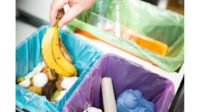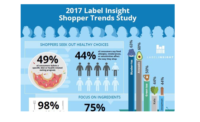Surveys: Consumers reading labels more
Surveys: Consumers reading labels more
Food safety concerns, a desire to know the origin of food products and dietary restrictions related to health or religion are among the factors driving consumers to seek more information about the foods they buy. They’re seeking that information on labeling as well as other sources, such as mainstream media or the Internet, according to the reports.
A survey of American consumers by The Hartman Group reported that 30% of respondents said they read product labels “much more often” now than last year, and another 31% said they read labels “slightly more often.”
“Label reading can be seen as elements of lifestyle, meaning there are a number of driving forces that trigger consumers to ‘interrogate’ the packages they purchase,” the report says.
The Hartman report identified reasons why consumers are paying increasing attention to labels:
• 76% said they are trying to eat more healthily.
• 59% said it was part of their normal cautiousness about what is in their food.
• 46% said they were concerned about food freshness.
• 45% said they are trying to keep their weight down.
• 41% said they were concerned about where the food’s ingredients came from.
Additionally, a survey by the consumer product group of consulting group Deloitte showed that 33% of respondents look for information about country of origin on packaging as a result of recent food product recalls. In addition, eco-friendly packaging and production was cited as an important purchase factor by 35% of respondents.
“As knowledge proliferates, there is a tendency for products to commoditize,” says Pat Conroy, vice chairman and U.S. consumer products group leader at Deloitte & Touche USA LLP. “To successfully compete, it’s imperative for consumer brands to build and maintain their images, create differentiation and enhance loyalty.”
The Deloitte survey also showed that Internet reviews of food products have a big impact: 62% of consumers said they read them, and of those, 82% said the reviews directly influenced their buying decisions.
The Food Safety and Inspection Service, the arm of the U.S. Agriculture Department responsible for meat plant inspection, has announced new initiatives for targeted testing, accurate recording, close monitoring, adequate training of inspectors and faster recalls. The changes will include: inspecting trim (the basis for ground beef) at the slaughterhouse, before it gets to the processor; better tracking procedural changes at both slaughterhouses and processing plants; and stepping up inspections at plants that rack up a high number of positives on pathogen tests.
The Center for Science in the Public Interest, a leading critic of the processed food industry, recently issued a white paper (www.cspinet.org/new/pdf/fswhitepaper.pdf) calling for enhancements to food safety programs, including: A process control program, similar to the meat industry’s HACCP (Hazard Analysis and Critical Control Points), that would be mandatory for all food plants; frequent, intensive inspections of high-risk products; and certification of food safety programs and facilities in foreign countries.
The panel discussion, moderated by Food & Drug Packaging Chief Editor Lisa Pierce, was entitled “Automation Skills Training in Germany: Are We Missing ‘Das Boot?’” The main speaker, John Kowal of packaging-equipment automation supplier Elau, pointed out that technicians in Germany get 31/2 years of education, about half of it in the form of practical, hands-on internships. In the U.S., technicians get two years of education that doesn’t always involve the most up-to-date control systems or real machinery.
The discussion centered on “mechatronics,” the combination of mechanical, electrical and software engineering needed to optimize automation. Kowal pointed out that most U.S. engineering schools still divide electrical/electronic, computer science and mechanical disciplines into separate programs.
At the seminar, panelists and the audience got the news that Purdue University Calumet of the Purdue University system will offer North America’s first comprehensive, packaging machinery-focused mechatronics engineering technology program.
Alcoholic beverages are among the top targets of counterfeiters, because of both their inherent value and the high taxes levied against them, the report said. One respondent to an OECD survey estimated his liquor company’s lost sales to counterfeits at more than $50 million annually.
Counterfeiting techniques range from simply pouring inferior products into genuine bottles to sophisticated operations that print phony labels and even mold fake bottles. Among food products that are counterfeited, the OECD listed kiwis, canned vegetables, milk powder, butter, baby food, instant coffee and candy. The OECD is an organization of 30 countries, including the United States, dedicated to the principles of representative democracy and a free-market economy.
Surveys: Consumers reading labels more
Consumers are looking to packaging for more, and more varied, information than ever, according to a pair of recent surveys.Food safety concerns, a desire to know the origin of food products and dietary restrictions related to health or religion are among the factors driving consumers to seek more information about the foods they buy. They’re seeking that information on labeling as well as other sources, such as mainstream media or the Internet, according to the reports.
A survey of American consumers by The Hartman Group reported that 30% of respondents said they read product labels “much more often” now than last year, and another 31% said they read labels “slightly more often.”
“Label reading can be seen as elements of lifestyle, meaning there are a number of driving forces that trigger consumers to ‘interrogate’ the packages they purchase,” the report says.
The Hartman report identified reasons why consumers are paying increasing attention to labels:
• 76% said they are trying to eat more healthily.
• 59% said it was part of their normal cautiousness about what is in their food.
• 46% said they were concerned about food freshness.
• 45% said they are trying to keep their weight down.
• 41% said they were concerned about where the food’s ingredients came from.
Additionally, a survey by the consumer product group of consulting group Deloitte showed that 33% of respondents look for information about country of origin on packaging as a result of recent food product recalls. In addition, eco-friendly packaging and production was cited as an important purchase factor by 35% of respondents.
“As knowledge proliferates, there is a tendency for products to commoditize,” says Pat Conroy, vice chairman and U.S. consumer products group leader at Deloitte & Touche USA LLP. “To successfully compete, it’s imperative for consumer brands to build and maintain their images, create differentiation and enhance loyalty.”
The Deloitte survey also showed that Internet reviews of food products have a big impact: 62% of consumers said they read them, and of those, 82% said the reviews directly influenced their buying decisions.
U.S. food safety efforts intensify
The federal government is stepping up its inspection process for meat processing plants, but a consumer advocacy group is urging it to go further.The Food Safety and Inspection Service, the arm of the U.S. Agriculture Department responsible for meat plant inspection, has announced new initiatives for targeted testing, accurate recording, close monitoring, adequate training of inspectors and faster recalls. The changes will include: inspecting trim (the basis for ground beef) at the slaughterhouse, before it gets to the processor; better tracking procedural changes at both slaughterhouses and processing plants; and stepping up inspections at plants that rack up a high number of positives on pathogen tests.
The Center for Science in the Public Interest, a leading critic of the processed food industry, recently issued a white paper (www.cspinet.org/new/pdf/fswhitepaper.pdf) calling for enhancements to food safety programs, including: A process control program, similar to the meat industry’s HACCP (Hazard Analysis and Critical Control Points), that would be mandatory for all food plants; frequent, intensive inspections of high-risk products; and certification of food safety programs and facilities in foreign countries.
Program to help close 'mechatronics' gap
Maintenance technicians in America get much less practical training than their counterparts in Germany, but a program announced at a panel discussion at the recent Pack Expo trade show may help change that.The panel discussion, moderated by Food & Drug Packaging Chief Editor Lisa Pierce, was entitled “Automation Skills Training in Germany: Are We Missing ‘Das Boot?’” The main speaker, John Kowal of packaging-equipment automation supplier Elau, pointed out that technicians in Germany get 31/2 years of education, about half of it in the form of practical, hands-on internships. In the U.S., technicians get two years of education that doesn’t always involve the most up-to-date control systems or real machinery.
The discussion centered on “mechatronics,” the combination of mechanical, electrical and software engineering needed to optimize automation. Kowal pointed out that most U.S. engineering schools still divide electrical/electronic, computer science and mechanical disciplines into separate programs.
At the seminar, panelists and the audience got the news that Purdue University Calumet of the Purdue University system will offer North America’s first comprehensive, packaging machinery-focused mechatronics engineering technology program.
Alcohol, food fakes on rise
Counterfeiting of foods and beverages is increasing, and the annual losses to the U.S. liquor industry are probably tens of millions of dollars a year, according to a report by the Organisation for Economic Co-operation and Development (OECD).Alcoholic beverages are among the top targets of counterfeiters, because of both their inherent value and the high taxes levied against them, the report said. One respondent to an OECD survey estimated his liquor company’s lost sales to counterfeits at more than $50 million annually.
Counterfeiting techniques range from simply pouring inferior products into genuine bottles to sophisticated operations that print phony labels and even mold fake bottles. Among food products that are counterfeited, the OECD listed kiwis, canned vegetables, milk powder, butter, baby food, instant coffee and candy. The OECD is an organization of 30 countries, including the United States, dedicated to the principles of representative democracy and a free-market economy.
Looking for a reprint of this article?
From high-res PDFs to custom plaques, order your copy today!





